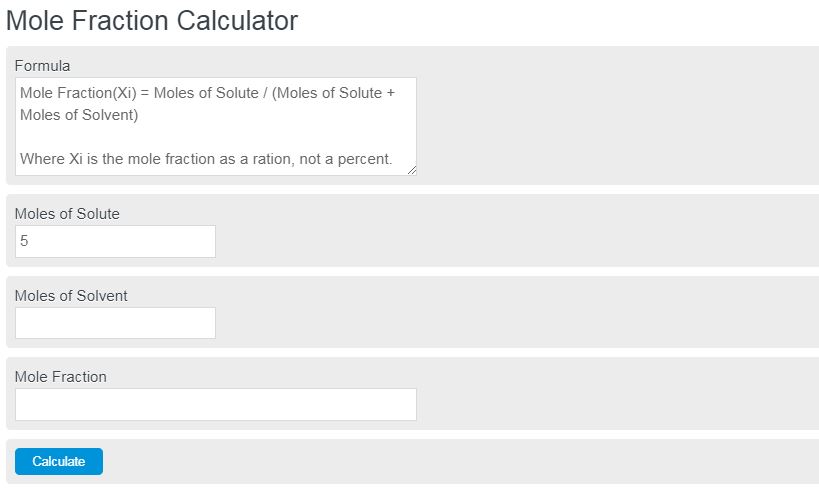Enter the moles of solute and moles of sloven into the mole fraction calculator below. The mole fraction is the ratio of moles of solute to total moles.
Mole Fraction Formula
The following formula is used in the mole fraction calculator above:
MF = Moles of Solute / (Moles of Solute + Moles of Solvent)
- Where Xi is the mole fraction as a ratio, not a percent.
Mole Fraction Definition
The mole fraction can be defined as the number of moles of a solute divided by the total amount of moles of the solution. This can be seen in the equation given above.
A mole fraction can be converted into a mole percent, or molar percentage, by multiplying the result of the mole fraction by 100. Unlike molar concentration, the mole fraction is a ratio of moles to moles. A molar concentration is a ratio of moles to volume.
How to calculate a mole fraction
The following example is a step-by-step guide to calculating a mole fraction. This example follows the formula given above.
- First, the total amount of moles of solute and solvent needs to be calculated. This can be done by measuring the mass and determining the number of moles per unit mass.
- The next step is to separate the solute and repeat step one.
- Finally, enter the information into the formula or calculator above.
- Analyze the results.
FAQ
The mole fraction can be defined as the number of moles of a solute divided by the total amount of moles of the solution.
FAQ
What is the difference between mole fraction and molarity?Mole fraction is the ratio of the number of moles of a solute to the total number of moles in the solution, whereas molarity is the concentration of a solute in a solution expressed as the number of moles of solute per liter of solution.
How can you convert mole fraction to mole percent?To convert a mole fraction to a mole percent, you multiply the mole fraction by 100. This converts the decimal fraction to a percentage that represents the moles of solute per 100 moles of solution.
Why is mole fraction important in chemistry?Mole fraction is important in chemistry because it is a way to express the composition of a mixture without depending on the volume, which can change with temperature and pressure. It is particularly useful in the study of colligative properties and when dealing with gas mixtures.
Can mole fraction be greater than 1?No, mole fraction cannot be greater than 1. Since it is the ratio of the moles of solute to the total moles in the solution, its maximum value is 1, which would only occur if there were no solvent present, contradicting the definition of a solution.
